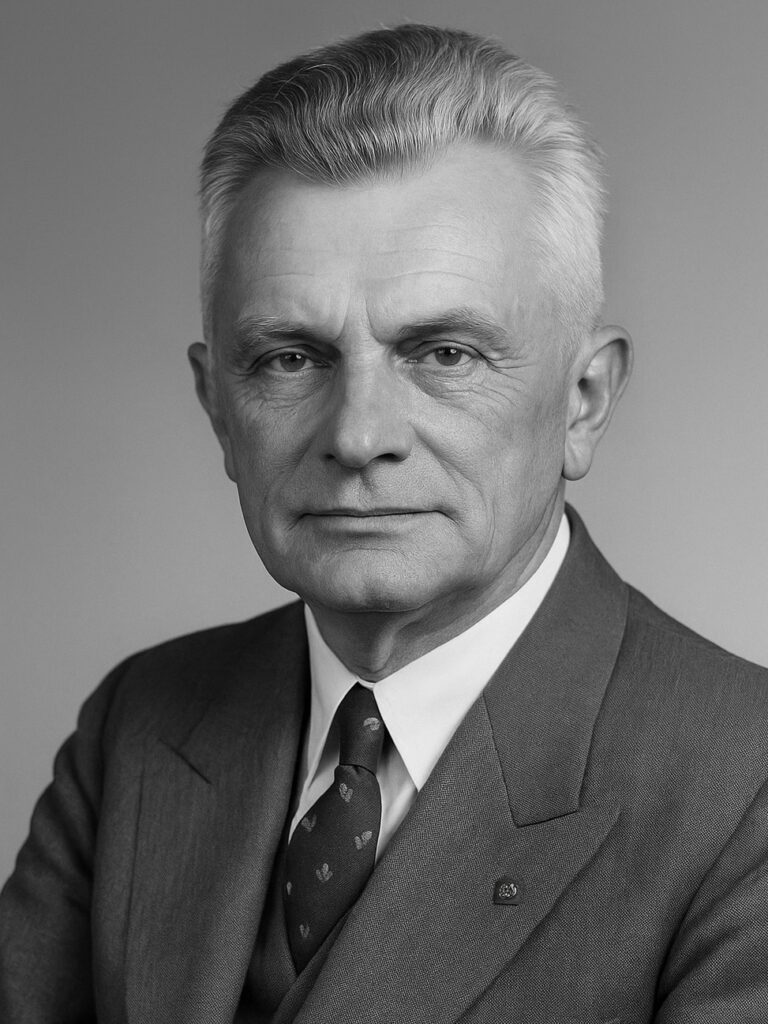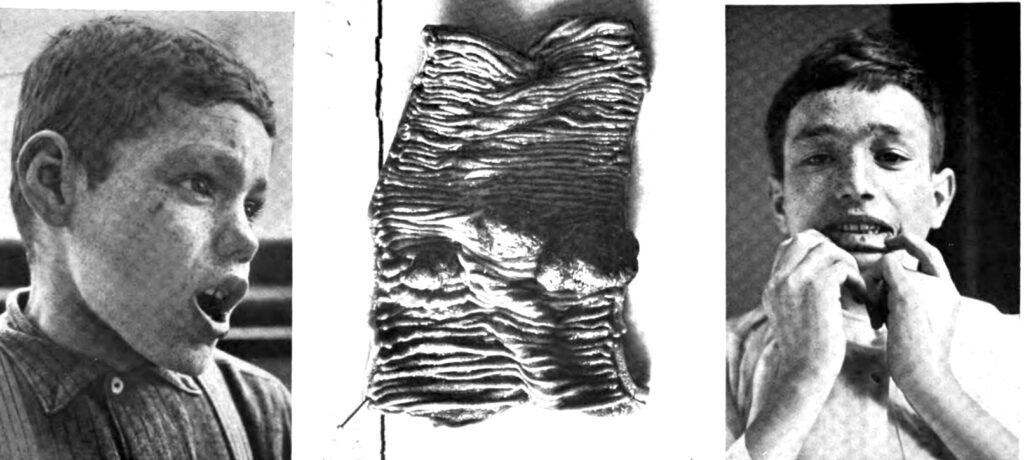Johannes Peutz

Johannes Laurentius Augustinus Peutz (1886-1957) was a Dutch physician.
Johannes “Jan” Peutz was best known for his 1921 description of the hereditary syndrome later eponymised as Peutz-Jeghers syndrome. A meticulous clinician and teacher, Peutz spent the majority of his career in The Hague, where he helped establish modern internal medicine practice at the Westeinde Hospital.
Peutz was born on 24 March 1886 in Uithuizen, a village in the province of Groningen in the northern Netherlands. He was the eldest of nine children in a Catholic family; his father was a school principal, and his maternal lineage carried a known history of diabetes mellitus, which would later influence his medical research. Peutz attended Rolduc College in Kerkrade before commencing medical studies in 1905. He trained under renowned physicians Karel Frederik Wenckebach (1864–1940) in Groningen and Albert Abraham Hijmans van den Bergh (1869–1943) in Utrecht, graduating in 1914.
Following graduation, Peutz began residency training in internal medicine at Coolsingel Hospital in Rotterdam in 1915. He also expanded his clinical perspective through visits to medical institutions in Germany, Italy, and Belgium. In 1916, he published his first scientific paper, exploring vaccination therapy for typhoid fever. The following year, Peutz was appointed chief physician at the Catholic Johannes de Deo Hospital in The Hague, where he would remain for 34 years.
In 1918, Peutz initiated major advancements in the hospital’s diagnostic and clinical infrastructure, co-founding laboratories for pathology, serology, and internal medicine, and installing electrocardiography services. Notably, the pathology department’s first head was Karl Landsteiner (1868–1943), future Nobel laureate and discoverer of blood groups. Peutz’s commitment to combining clinical acumen with investigative rigor culminated in his 1921 doctoral thesis on pancreatic disease and diabetes, awarded by the University of Utrecht.
Biography
- 1886 – Born March 24 in Uithuizen, Netherlands; eldest of nine children
- 1905 – Began medical studies at the Universities of Groningen and Utrecht
- 1914 – Graduated in medicine; studied under Karel Frederik Wenckebach (1864–1940) and Albert Abraham Hijmans van den Bergh (1869–1943)
- 1915 – Commenced internal medicine residency at Coolsingel Hospital, Rotterdam; also visited clinics in Germany, Italy, and Belgium
- 1916 – Published early work on vaccination therapy for typhoid fever
- 1917 – Appointed chief physician at the Johannes de Deo Hospital (later Roman Catholic Westeinde Hospital) in The Hague
- 1918 – Founded laboratories for pathological, serological, and internal medicine investigations; established ECG services; collaborated with Karl Landsteiner (1868–1943)
- 1921 – Awarded PhD from University of Utrecht: Clinical and experimental contribution to the diagnosis and internal therapy of pancreatic disorders, with particular reference to diabetes
- 1921 – Published landmark case of familial polyposis with mucocutaneous pigmentation, now known as Peutz-Jeghers syndrome
- 1944 – Published work on bed rest in the treatment of gastric and duodenal ulcers
- 1950 – Inspired Th. van Wijk to publish his thesis on the Peutz family syndrome
- 1951 – Retired as head of Department of Internal Medicine, Westeinde Hospital
- 1950s – Received multiple honours including the Pro Ecclesia et Pontifice, Order of St. Gregorius the Great, and Order of Oranje-Nassau
- 1957 – Died December 20 in The Hague, Netherlands
Medical Eponyms
Peutz-Jeghers syndrome (1921)
Peutz-Jeghers syndrome is an autosomal dominant condition caused by mutations in the serine/threonine kinase 11 gene (STK11/LKB1) is characterised by melanotic macules; gastrointestinal hamartomatous polyps; and increased cancer risk.
1921 – Peutz described a 15-year-old boy with poor appetite, and intermittent abdominal pain, later developing an ileus from jejunal polyps. The patient had numerous distinctive pigmented spots on his face and mouth, with numerous ‘pea to grape sized’ rectal polyps and rectal pigmentation also observed on rectoscopy. Evaluation of the patient’s family revealed similar pigmentation in 5 of the 7 siblings and the father. The father had two sisters who died from intestinal obstruction.
Peutz considered that this was a congenital and familial syndrome, characterised by intestinal polyps, nasal polyps, and the distinctive pigmentation.
Terwijl nu het voorkomen der polypen in den darm als een familiaire ziekte een welbekend iets is, geven mijn ge vallen een dusdanige aanvulling van de kennis van het ziektebeeld, waarover ik tenminste in de literatuur nog niets vond vermeld. Want ik vond nl., zooals reeds werd gezegd, behalve de darmpolypen nog in 2 der 5 gevallen neuspolypen en van de 7 kinderen 5 met de beschreven pigmentatie benevens de 2 gevallen – zusters van den vader – waar anamnestisch ook diezelfde pigmentatie aan wezig bleek. Het lijkt mij zeer waarschijnlijk dat ook deze veranderingen in samenhang staan met de congenitale stoor nis, die tot het optreden van de polyposis geleid heeft.
While the occurrence of the polyps in the intestine as a familial disease is well-known, my cases add to the knowledge of the clinical picture, not previously reported in the literature. In addition to the intestinal polyps I found nasal polyps (2 of the 5 cases) and the described mucous membrane pigmentation (5 of the 7 children). In a further 2 cases – sisters of the father – the same pigmentation was present. It seems to me very likely that these changes are related to the congenital disorder which led to the appearance of the polyposis.

Peutz 1921
1950 – van Wijk, supervised by Peutz, wrote his thesis on the original family with the condition, which he referred to as ‘Peutz disease’
Major Publications
- Peutz JLA. Enkele opmerkingen over vaccinotherapie bij febris typhoidea. Uit de Geneeskundige Afdeeling (Dr. H. Burgerhout) en het Laboratorium (Dr. R. De Josselin de Jong) van het ziekenhuis aan den Coolsingel te Rotterdam. Nederlandsch Maandschrift voor Geneeskunde. 1916;555–567.
- Peutz JLA. Iets over vetstoffen in de urine (Uit het R.K. Ziekenhuis, Westeinde, ‘s Gravanhage). Nederlandsch Maandschrift voor Geneeskunde. 1918;728–739.
- Peutz JLA. Over een zeer merkwaardige, gecombineerde familiaire polyposis van de slijmvliezen, van den tractus intestinalis met die van de neuskeelholte en gepaard met eigenaardige pigmentaties van huid- en slijmvliezen. Nederlandsch Maandschrift voor Geneeskunde. 1921;10: 134-146 [PDF] [Peutz-Jeghers syndrome – case report]
- Peutz JLA. Bedrust als voornaamste middel bij de behandeling van maag- en duodenumzweren. Nederlands Tijdschrift voor Geneeskunde, 1944;88:113–115
References
Biography
- Van Wijk, TW. In memoriam Dr. Johannes Laurentius Augustinus Peutz. Nederlands Tijdschrift voor Geneeskunde, 1958; 102: 404–405
- Beighton P, Beighton G. Johannes Laurentius Augustinus Peutz (1886-1957). In: The Man Behind the Syndrome. Springer 1991 134-136
- Offerhaus GJ, Regnerus Peutz H, Giardiello FM. Biographical sketch of Jan Peutz. Gastroenterology. 2008; 134(5): 1628-1629
- Peutz-Kootstra CJ. Peutz, Johannes Laurentius Augustinus (1886–1957). In: van Krieken J. (eds) Encyclopedia of Pathology. 2016
Eponymous terms
- van Wijk ThW. Over het syndroom polyposis adenomatosa gastro-intestinalis generalisata heredofamiliaris gecombineerd met huid- en slijmvliespigmentaties of ziekte van Peutz (thesis). Leiden. 1950.
- Alm T. Männen bakom syndromet: Johannes Peutz och Harold Jeghers. Utforskare av underdiagnostiserat tillstånd med tarmpolyper och mukokutana pigmenteringar [The men behind the syndrome: Johannes Peutz and Harold Jeghers. The explorers of an underdiagnosed condition with intestinal polyps and mucocutaneous pigmentations]. Lakartidningen. 1987 Jul 8;84(28-29):2351-3.
- Westerman AM, Entius MM, de Baar E, et al. Peutz-Jeghers syndrome: 78-year follow-up of the original family. Lancet. 1999;353(9160):1211-1215.
- Keller JJ, Offerhaus GJ, Giardiello FM, Menko FH. Jan Peutz, Harold Jeghers and a remarkable combination of polyposis and pigmentation of the skin and mucous membranes. Fam Cancer. 2001;1(3-4):181-185
Eponym
the person behind the name
Doctor in Australia. Keen interest in internal medicine, medical education, and medical history.
BA MA (Oxon) MBChB (Edin) FACEM FFSEM. Emergency physician, Sir Charles Gairdner Hospital. Passion for rugby; medical history; medical education; and asynchronous learning #FOAMed evangelist. Co-founder and CTO of Life in the Fast lane | On Call: Principles and Protocol 4e| Eponyms | Books |
